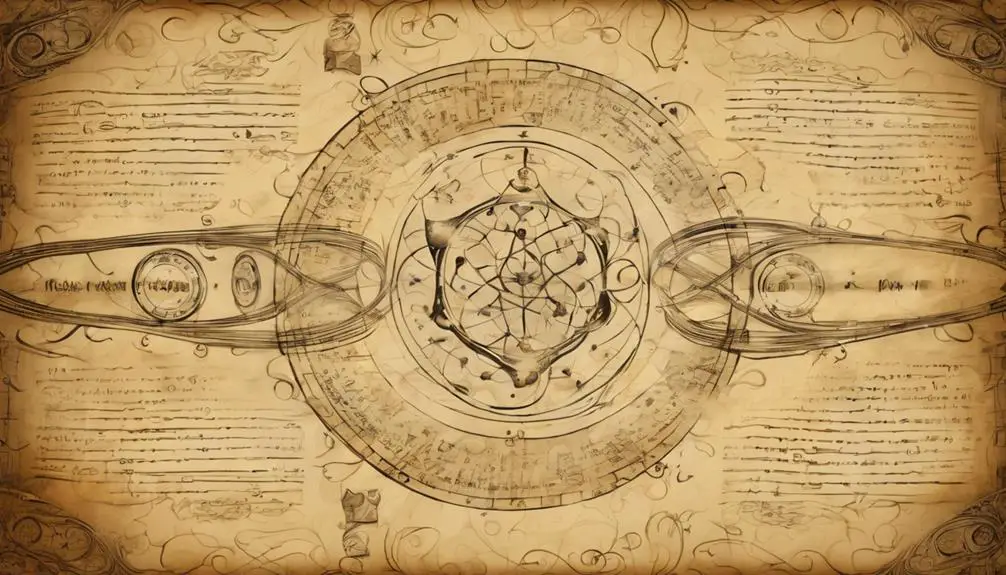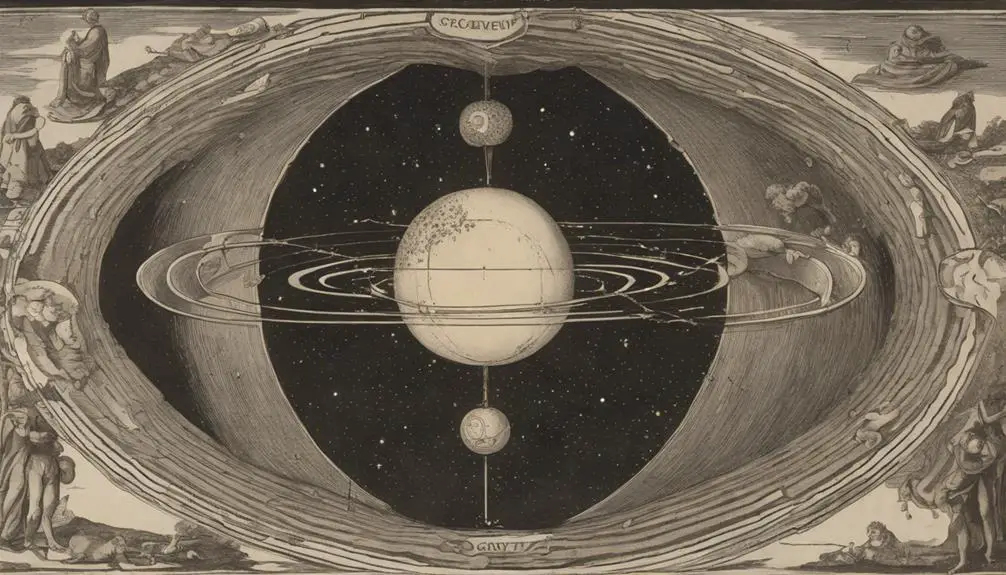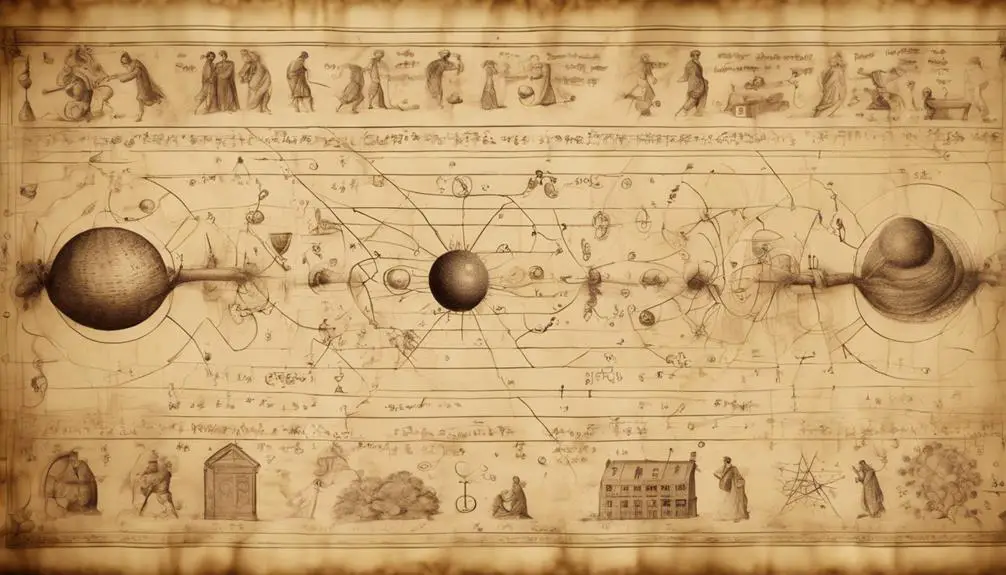Witness the compelling convergence of physics and scripture as we unravel surprising scientific concepts hidden within the Bible's ancient verses.

Physics in the Bible
While you might initially think that the Bible and physics exist in separate realms, it's quite intriguing to draw parallels between the two.
Consider this: could ancient scriptures contain insights into the natural world that align with modern physics?
Let's suspend our skepticism and explore instances where Biblical passages hint at concepts like light, gravity, time, and quantum mechanics.
This unexpected intersection just might deepen your understanding and curiosity, and who knows what fascinating connections you'll discover next?
Key Takeaways
- The Bible contains embedded physics principles, suggesting an understanding of concepts like gravity, light, and quantum phenomena.
- Biblical miracles can be related to physics laws, potentially accelerating natural processes or manifesting divine energies.
- Light and time perception in the Bible align with modern physics, symbolizing divinity and hinting at concepts like refraction and time dilation.
- Ancient scriptures hint at physics concepts such as thermodynamics and electromagnetism, offering insights into miraculous events and divine commands.
Miracles and Laws of Physics

While you might perceive miracles in the Bible as supernatural phenomena, they can often be analyzed and understood within the framework of physics laws. This doesn't necessarily strip them of their divine nature, but instead offers a different lens through which to view these extraordinary events. When considering miraculous healings, for example, you could look at them not as a suspension of natural laws, but as an acceleration of the body's normal healing processes.
Yet, this isn't to suggest that all miracles can be neatly categorized under known physics principles. Take physical manifestations, for instance. These are instances where divine entities or energies are said to have taken a form perceivable to the human senses, a concept that certainly seems to defy our current understanding of physical laws. Nonetheless, quantum physics, with its particles that can exist in multiple places at the same time, offers a hint of how such manifestations might be possible.
Biblical Descriptions of Light

Shifting our focus to the biblical descriptions of light, you'll find that they offer profound insights when scrutinized through the lens of modern physics. Light symbolism is a key element in the Bible; it's often used to denote divinity, purity, and truth. For instance, Psalm 119:105 describes it as a lamp to our feet and a light to our path, signifying spiritual guidance.
Take a closer look at Biblical refraction, which is the bending of light. It's interesting to note the instances where light isn't only treated as an illumination source but also as an entity capable of being refracted, reflected, and scattered, much like what we understand in the realm of physics today.
The account of Moses' encounter with God in a burning bush (Exodus 3:2) is a perfect example. Here, the light emitted from the bush isn't consumed, which could be interpreted as a form of energy conservation.
Gravity and the Biblical Cosmos

Diving into the concept of gravity within the Biblical cosmos, you'll find that although the term itself isn't explicitly mentioned, there are passages that hint at a deep understanding of forces holding the universe together. In Job 26:7, it's stated that God 'hangs the earth on nothing,' a phrase which could suggest a comprehension of invisible forces, such as gravity, maintaining the cosmic structure.
In the same vein, the Biblical Gravitational References in Isaiah 40:22 describes the earth as a circle, suspended in the void, implying an understanding of our planet's circular shape and its position in space, held by unseen gravitational forces.
The Psalms, too, offer insightful glimpses into the Biblical cosmos' structure. Psalms 104:5 states, 'He set the earth on its foundations; it can never be moved.' While at first glance this may seem to contradict our understanding of the earth's orbital motion, it could metaphorically suggest the constant, reliable nature of gravitational forces acting on the earth.
Time Perception in Scripture

On the heels of understanding gravity's metaphorical presence in the Bible, let's turn our attention towards another intriguing concept: the perception of time in Scripture. You'll find that time, as depicted in the Bible, doesn't always adhere to our linear, human understanding. This concept, often referred to as 'Scriptural relativity,' posits that the divine perception of time may differ from our own.
For instance, 2 Peter 3:8 states, 'One day is with the Lord as a thousand years, and a thousand years as one day.' This verse suggests a dilated perception of time, akin to Einstein's theory of relativity within Biblical spacetime.
Notice how this scripture implies a time elasticity, where the divine day can stretch to encompass a millennium or shrink to a moment. It's an indication of God's transcendence over time and space, a concept that aligns with modern physics' understanding of spacetime.
Physics Concepts in Ancient Texts

Peeling back the layers of ancient texts, you'll find a surprising wealth of physics concepts embedded in their narratives. By examining these documents, you'll unearth the roots of 'Scriptural Thermodynamics' and 'Biblical Electromagnetism'.
Perhaps you've questioned the feasibility of Jonah surviving inside a whale or Moses parting the Red Sea. These incidents may seem fantastical, but they can be interpreted in the context of physics. For instance, the concept of entropy, a cornerstone of thermodynamics, may offer insight into the order from chaos depicted in Genesis.
Biblical electromagnetism, on the other hand, is seen in the divine commands and miracles involving light, energy, and matter. The voice of God at Sinai, the luminous transfiguration of Jesus, could represent electromagnetic phenomena.
Consider the table below, which outlines some instances of physics in ancient texts:
Text |
Physics Concept |
Example |
|---|---|---|
Genesis |
Scriptural Thermodynamics |
Creation of the universe |
Exodus |
Biblical Electromagnetism |
Moses' burning bush |
Jonah |
Underwater Pressure Physics |
Jonah inside the whale |
Quantum Mechanics and Biblical Interpretations

Venturing into the realm of quantum mechanics, you'll find intriguing parallels between its principles and certain biblical interpretations. The concept of Quantum Prophecy closely aligns with the biblical idea of prophecy – foreknowledge of events. Just as quantum physics suggests that particles can exist in multiple states until observed, biblical prophecy implies a similar superposition of future possibilities.
Consider the Biblical Superposition. This concept, akin to Schrödinger's famous cat thought experiment, argues that God's omniscience doesn't necessarily fix future events, but rather holds all possibilities in a state of superposition until they're 'observed' or actualized. This perspective aligns with open theism, a theological position that posits an unfixed future.
The Apostle Paul's words in 1 Corinthians 13:12, 'For now we see through a glass, darkly,' can be interpreted as a reflection of the quantum uncertainty principle – we can never be certain of both a particle's position and momentum at the same time.
Frequently Asked Questions
How Does the Bible Reconcile With the Concept of Multi-Dimensional Physics?
You're pondering how multi-dimensional physics might align with biblical dimensions. It's a bit like quantum theology, isn't it?
The Bible doesn't directly address scientific theories. But, some interpret its spiritual teachings as metaphorical insights into complex realities, like multiple dimensions.
It's crucial, though, to keep in mind that scientific concepts and religious texts often approach understanding the universe differently.
Is There Any Reference to the Theory of Relativity in the Bible?
You're asking if the Bible references the theory of relativity. It's important to note that biblical texts predate such scientific theories.
However, some interpretations might draw parallels between relativity concepts and certain biblical cosmology. But remember, these are interpretive stretches, not explicit mentions.
Scientific concepts like relativity weren't in the biblical authors' purview. Thus, any connection is more about contemporary interpretation than original intent.
Does the Bible Suggest Any Form of Energy Other Than What Is Already Known in Physics?
You're asking if the Bible hints at unknown forms of energy.
Well, it's worth considering concepts like 'Biblical Thermodynamics' or 'Divine Energy.'
However, it's crucial to note that the Bible isn't a scientific text.
It encompasses metaphysical and spiritual truths, which may not necessarily align with our current understanding of physics.
What Do Scriptures Say About the Concept of Dark Matter and Dark Energy?
The scriptures don't directly address the concepts of dark matter and dark energy. When discussing Scriptural Cosmology, it's important to note that the Biblical Universe isn't described in modern scientific terms.
However, you could interpret certain passages as hinting towards these unseen forces. It's a matter of interpretation and understanding the text within its historical and cultural context.
Are There Any Biblical References That Align With the Idea of String Theory?
You're looking for biblical references that might correlate with string theory, yes?
While the Bible doesn't explicitly discuss 'Biblical Quantum Mechanics' or 'Scriptural Particle Physics,' it's key to remember it's not a scientific text.
However, some believe analogies can be drawn between biblical concepts and quantum physics, but it's largely interpretational and not direct.
There's no definitive consensus on such correlations.
Conclusion
In conclusion, you've seen that the Bible, despite its ancient origins, contains elements relatable to modern physics. It's intriguing how miracles challenge laws of physics, light and gravity find biblical references, time perception is discussed, and quantum mechanics can be inferred.
Therefore, the Bible isn't just spiritual, but also a potential source of scientific curiosity and exploration. This convergence of faith and science encourages a deeper, multidimensional understanding of this revered text.



Sign up